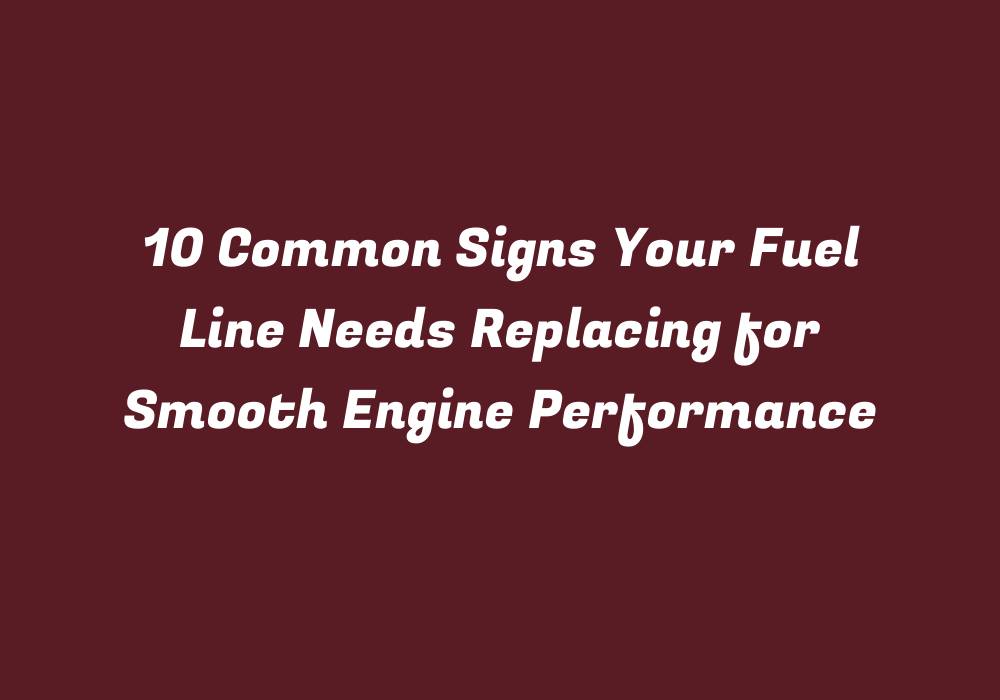10 Common Signs Your Fuel Line Needs Replacing for Smooth Engine Performance
A well-functioning fuel line is critical to ensuring smooth and efficient engine performance in vehicles. Unfortunately, over time, these lines can become damaged or worn out due to exposure to harsh environmental elements. Here are 10 common signs indicating that your fuel line needs replacing for optimal engine functionality.
1. Engine Misfires
Engine misfires occur when the spark plug does not ignite the fuel-air mixture effectively, causing a temporary loss of power during combustion. If you’re experiencing frequent misfires, it might be due to a malfunctioning or worn-out fuel line that is preventing adequate fuel flow to the engine cylinders.
2. Reduced Fuel Efficiency
A faulty fuel line can hinder proper fuel delivery, causing your vehicle to consume more gas than usual. If you notice a sudden decrease in mileage per gallon or increased fuel costs, it’s likely that your fuel line is in need of replacement.
3. Engine Sputtering
Engine sputtering refers to irregular engine idling that can lead to a rough and uneven performance. If you’re experiencing engine sputtering alongside the other signs mentioned in this article, it might be due to restricted or insufficient fuel flow caused by a worn-out or damaged fuel line.
4. Strange Vehicle Noises
Several unusual sounds, such as knocking, rattling, and whining noises, could indicate that the fuel lines are loose or have become damaged over time. If you can’t identify a particular source of these noises, it might be worth having your fuel line inspected.
5. Visible Fuel Leaks
One of the most obvious signs that your fuel lines need replacing is visible fuel leaking from the system. If you notice any fluid on the ground underneath your vehicle after parking or during operation, this could be an indication of a damaged fuel line and should be addressed promptly to prevent further issues.
6. Weak Acceleration
Weak acceleration is another common symptom of faulty fuel lines, as the engine struggles to maintain power while under load due to restricted or insufficient fuel supply. If you’re experiencing difficulties when attempting to accelerate your vehicle, this could point towards a problem with your fuel line system.
7. Vehicle Stalling
Vehicle stalls can occur when the fuel supply is disrupted or interrupted, causing a loss of power and preventing the engine from functioning correctly. If you’re frequently experiencing vehicle stalls and have ruled out other possible causes, it could be time to consider inspecting your fuel line system.
8. Unusual Smells
A damaged or leaking fuel line can sometimes result in the release of fumes from the fuel tank into the cabin area. If you smell gasoline when inside your vehicle, it’s essential to have the issue addressed immediately for both safety and performance reasons.
9. Difficulty Starting the Engine
If your engine has difficulty starting or takes multiple attempts before finally firing up, it could be due to a faulty fuel line that is preventing the correct amount of fuel from reaching the cylinders during ignition.
10. Exhaust Smoke and Emissions Issues
Excessive smoke coming from your exhaust or increased emissions levels can be a result of inefficient fuel delivery, which is often caused by damaged or worn-out fuel lines. If you’ve noticed any changes to your vehicle’s emissions, it might be time for an inspection and potential replacement of the fuel line.
In conclusion, monitoring these 10 common signs can help identify issues with your fuel line before they lead to more significant problems, such as engine damage or safety hazards. Regular maintenance and timely replacement of faulty components are crucial for maintaining optimal engine performance and ensuring a smooth driving experience.
